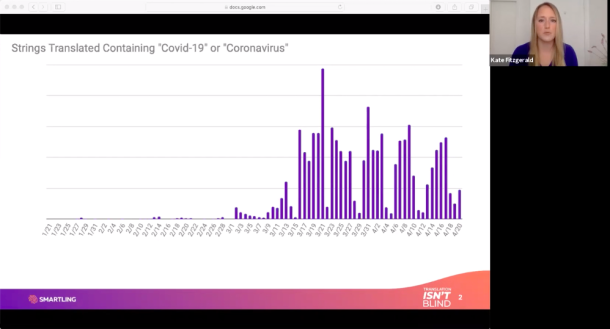Developing a marketing program is complex. It involves many tactics, content types, distribution channels, and ideal customer profiles within a market. In contrast, imagine the huge task that is developing a global marketing strategy. While it’s not easy, it’s also not a challenge you should shy away from.
You can tackle global marketing successfully and enjoy the benefits that come with it—you just need the right knowledge and tools. Here’s what you need to know.
What global marketing is (and how it differs from domestic marketing)
Global marketing is the practice of promoting your company in worldwide markets. This is unlike domestic marketing, which is limited to markets within your own country.
Global marketing is much broader in its purpose and reach. But, to be clear, it isn’t about trying to sell to everyone (or people in every country) by default. That’s still a rookie marketing mistake. It's an almost surefire way for your marketing efforts to fall short of their potential.
Instead, global marketing strategy development involves researching markets where your product may be well-received. And, of course, planning to expand into those target markets. This often involves adjusting existing messaging, public relations, and other efforts for locals in each market. In other words, it involves localization with the goal of delivering native brand experiences.
Why is a global marketing strategy important?
Global marketing expands your company’s reach, giving you access to more potential customers. International business strategy in general is a way to tap into revenue opportunities your company is missing out on. Plus, it can give you a massive competitive edge if your domestic competitors aren’t marketing on a global scale.
A few common misconceptions about global marketing
We’ve explored what it is and why it’s valuable, but what are some common things companies misunderstand about it?
1. “Global marketing is too hard.”
It’s certainly not easy. There are many moving parts that add complexity, but it’s simpler than you might think. You’re already accustomed to doing extensive market research as well as tailoring your traditional marketing strategy to different domestic audiences. Global marketing involves both of these elements on a larger scale.
You already have the fundamental skills needed to be successful. The other half of the battle is putting teams and processes in place to launch and expand these efforts.
2. “Global marketing is only for massive enterprises.”
Not necessarily. Sure, large companies may have more resources to dedicate upfront. But all businesses small and large have access to the internet. It continues to expand the already-incredible limits of what’s possible in terms of reaching global audiences. You don’t need to have the resources of a Fortune 500 brand to launch an international marketing strategy. You can start building a global brand anytime.
3. “One marketing strategy will work across all English-speaking regions.”
There are many differences between America, Canada, England, and other predominantly English-speaking countries. In the words of Fernando Lopez, the Marketing Director at Circuit, this is because “language isn’t the biggest influence on culture.”
Whatever the reason, though, Lopez believes that “you absolutely cannot ignore these cultural differences. You must adjust messaging to different purchasing behavior, attitudes, and user experience expectations, even when you may not need to translate the language. The language itself may need adjustment, too, as local slang varies and messages can quickly become unclear.”
3 advantages of investing in global marketing
Global marketing strategy, which is inclusive of translation and localization, has numerous benefits. The main ones are, naturally, more opportunities to generate revenue and grow profit.
1. Revenue growth
There’s massive potential in the global market. Case in point: Marketing analytics alone is expected to grow from a $3.2 billion industry worldwide to $6.4 billion. Growth—or at least stability—within your industry could make globalization a lucrative move for your business. As long as you choose the regions you enter into wisely, of course.
2. Improved user experience
If you think about it, you might be participating in international marketing without realizing it. Your website probably already gets traffic from users in different countries who speak other languages.
What’s the advantage of providing localized, multilingual content? You connect with and create better user experiences for those consumers. After all, 65% of consumers prefer content in their own language. It can gradually convince them to become customers. Then, if and when they do, it results in better customer experiences. In turn, this boosts customer retention rates and loyalty.
Simply put, your marketing is more effective when consumers aren’t forced to:
- Interact with you in a language that isn’t their native tongue
- Communicate with your business in a way that doesn’t feel natural to them
3. Untapped content opportunities
This is a surprising benefit of going global that few talk about. Yet Ashley Woodyatt, the Marketing Manager at Woodyatt Curtains, notes this phenomenon:
“There are different content gaps in the marketing strategies of our competitors across different markets. As a result, we're able to get really granular regarding the types of content we put out on a per-market basis.”
In other words, you can capitalize on content opportunities that aren’t available domestically, enabling you to accomplish the following:
- Better meet the needs of your target markets
- Differentiate yourself from local competitors by providing more comprehensive topic coverage
- Establish yourself as a trusted authority and, therefore, a trusted solutions provider
All of the above have positive effects on marketing ROI.
3 challenges of building a global marketing strategy
What are some challenges you could encounter as you plan and execute your strategy?
1. Scaling up
The main challenge will likely be the sheer amount of work to do. Say you plan to enter the Chinese, Japanese, and Indian markets, for example. Across your ecommerce website, emails, and other marketing materials, you’ll need to translate hundreds of pieces of content into all relevant languages. Your goal is to provide localized experiences for consumers in all the countries you’re attempting to reach, which can be accomplished with the following:
- Exploring the nuances of those languages, dialects, and cultures
- Planning how the above will impact your marketing messaging for each region
- Determining which content is the highest priority for translation
- Putting together a translation team and defining what role each person will play
- Outlining what your translation workflow will look like
- Determining what elements of your marketing to standardize for efficiency and improve recognition of your brand name
- Establishing what your localization efforts will involve (besides just translation)
Additionally, there are other considerations such as cost and time to expand. Having expert support at every turn will be critical to your success. Smartling offers this support, providing the easiest way to manage content translation and marketing localization.
2. Adjusting your messaging
It can also be difficult to adjust your marketing message for each new market. You’ll need to know the linguistic differences, local tastes, cultural distinctions, behavior patterns, and sensitivities that exist. This is one reason it’s smart to work with professional translators like ours who are native speakers and local experts. They have valuable insights that would otherwise take a while to acquire for each foreign market or language.
3. Staying on top of of changes within foreign markets
Without a doubt you're familiar with the ebbs and flows of your local market. You may even be able to predict upcoming shifts with a measure of accuracy. But that’s likely not a competitive advantage you’ll have when going global with your marketing. Things can change and evolve differently than expected.
Doing ongoing research and paying close attention to patterns is essential. This is especially true when you’re not using software like Smartling’s Global Delivery Network. (The Global Delivery Network is a proxy server that dramatically reduces the time it takes to translate and publish content.) If you’re already losing time with a manual translation process, you won’t be able to pivot quickly based on market shifts.
Now, though, let’s see how to develop a global strategy that’s effective despite the above challenges.
How to get started with global marketing
What does it take to build a global marketing strategy that works?
Research global audiences
Identify a handful of global markets your company may be able to expand into successfully. One way you can do this is by reviewing your analytics data for clues.
For example, say your website gets many visitors from Latin America. It may be a good idea to translate your website and marketing content into Spanish. Especially if you see that, despite many visits from locals in that market, few return to your site or convert.
Once you’ve pinned down some markets that have potential, take a look at the following elements:
- Demographic info such as the age range and gender of potential customers
- Psychographic info including values, lifestyles, and interests
- Common pain points and goals
- Common keywords and terminology
- Any existing behavioral data you have from your analytics, for example
Do thorough market research to gather this information for each market. Focus groups, 1:1 interviews, public and commercial sources, and more can all be helpful in informing your strategy.
Identify your “new” competitors
You know who your biggest domestic competitors are. But, when you expand to different countries, you’ll compete against a whole new pool of businesses. Those businesses have a home advantage—they’re already known and perhaps also trusted in the markets they serve. Because they have this competitive edge, you need to know who these competitors are so you can learn from their marketing efforts.
Lay out your marketing plan
Based on what you know about each new market and the competitors within it, start setting goals. These should cover timelines and targets for the expansion, as well as marketing metrics to track.
From here, convert your raw research into an actionable marketing plan that will help you achieve the following:
- Attract more international business
- Make a positive impression (initially and consistently)
- Showcase how your ideal customers can and will benefit from what you offer
The information and formatting used in your existing marketing plan can serve as inspiration. For example, your current marketing mix could carry over to your global strategy. But keep in mind that these plans should be tailored for each local market. So, get specific about the nuances of the region. Consider how you should adapt your unique value proposition and overall messaging to be effective.
Put a team in place
The next question is: What resources will you need to execute your marketing strategy and reach your goals? You may have put some thought into the answer before reaching this step. However, now is decision-making time, and you must ensure that you have the necessary human resources.
Many companies assign country managers to oversee marketing localization efforts within their region. (These managers are especially valuable if they have marketing expertise in addition to local knowledge. They help make sure your marketing strategy is airtight and a fit for the market they’re overseeing.)
As with a standard marketing team, you’ll likely need the support of a variety of people:
- Brand or product managers
- Designers or developers
- SEO specialists
- Social media marketing managers
Some benefits of having such individuals on board are discussed in Deloitte’s 2022 Global Marketing Trends Report. One is the encouragement of lateral thinking, which drives progress toward your goals. Team members with different skill sets have different and valuable perspectives. The solutions to the challenges before you could be found in their input.
Lastly, we can’t forget to mention linguistic experts. These could be freelance translators or pros from translation agencies. Or you could work with Smartling’s translation experts — all of whom are native speakers with local expertise.
Test the waters
Before you go full steam ahead on global marketing campaigns, put your marketing mix and messaging to the test. This could include user testing or focus groups to gather feedback on region-specific marketing. That way, if there are any early indications that you’ve missed the mark, you can adjust before investing time, money, and other resources into larger-scale initiatives.
Ready to build a global brand?
Is an expansion into new markets on the horizon for your business? If so, you now have the knowledge to start planning a well-rounded strategy. Plus, you know what challenges to look out for and common misconceptions to avoid falling for.
It’s putting this knowledge into practice that’s the most challenging part. There are so many moving parts to account for. You will need support at some point to get and keep you on the right track with marketing localization. When that time comes, the Smartling team will be here for you. Consider this your open invitation to book a meeting with us!






